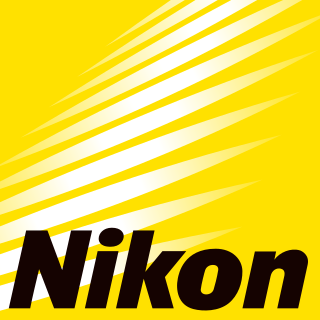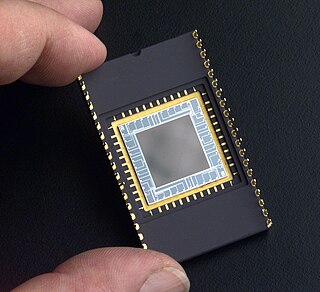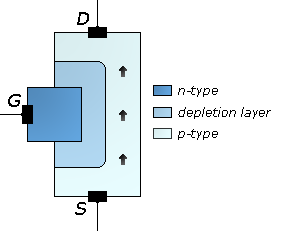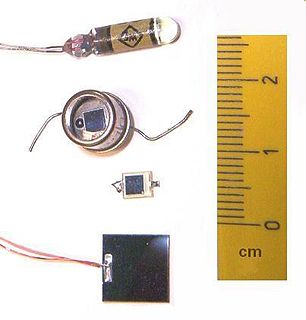
A photodiode is a semiconductor device that converts light into an electrical current. The current is generated when photons are absorbed in the photodiode. Photodiodes may contain optical filters, built-in lenses, and may have large or small surface areas. Photodiodes usually have a slower response time as their surface area increases. The common, traditional solar cell used to generate electric solar power is a large area photodiode.

A digital camera or digicam is a camera that captures photographs in digital memory. Most cameras produced today are digital, and while there are still dedicated digital cameras, many more cameras are now being incorporated into mobile devices, portable touchscreen computers, which can, among many other purposes, use their cameras to initiate live videotelephony and directly edit and upload imagery to others. However, high-end, high-definition dedicated cameras are still commonly used by professionals.
The Foveon X3 sensor is an image sensor for digital cameras, designed by Foveon, Inc. and manufactured by Dongbu Electronics. It uses an array of photosites, each of which consists of three vertically stacked photodiodes, organized in a two-dimensional grid. Each of the three stacked photodiodes responds to different wavelengths of light; that is, each has a different spectral sensitivity curve. This difference is because different wavelengths of light penetrate silicon to different depths. The signals from the three photodiodes are then processed, resulting in data that provides the amounts of three additive primary colors, red, green, and blue.
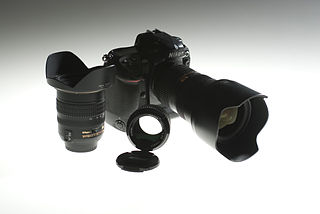
The Nikon D2X is a 12.4-megapixel professional digital single-lens reflex camera (DSLR) that Nikon Corporation announced on September 16, 2004. The D2X was the high-resolution flagship in Nikon's DSLR line until June 2006 when it was supplanted by the D2Xs and, in time, the Nikon D3 range, Nikon D4 range and Nikon D5 — the latter three using a FX full-format sensor.

Super CCD is a proprietary charge-coupled device that has been developed by Fujifilm since 1999. The Super CCD uses octagonal, rather than rectangular, pixels. This allows a higher horizontal and vertical resolution to be achieved than a traditional sensor of an equivalent pixel count.
A microbolometer is a specific type of bolometer used as a detector in a thermal camera. Infrared radiation with wavelengths between 7.5–14 μm strikes the detector material, heating it, and thus changing its electrical resistance. This resistance change is measured and processed into temperatures which can be used to create an image. Unlike other types of infrared detecting equipment, microbolometers do not require cooling.

The Nikon D1 is a digital single-lens reflex camera (DSLR) made by Nikon Corporation introduced on June 15, 1999. It featured a 2.7-megapixel image sensor, 4.5-frames-per-second continuous shooting, and accepted the full range of Nikon F-mount lenses. The camera body strongly resembled the F5 and had the same general layout of controls, allowing users of Nikon film SLR cameras to quickly become proficient in using the camera. Autofocus speed on the D1 series bodies is extremely fast, even with "screw-driven" AF lenses.

Image noise is random variation of brightness or color information in images, and is usually an aspect of electronic noise. It can be produced by the sensor and circuitry of a scanner or digital camera. Image noise can also originate in film grain and in the unavoidable shot noise of an ideal photon detector. Image noise is an undesirable by-product of image capture that obscures the desired information.

The Nikon D200 is a 10.2-megapixel digital single-lens reflex camera that falls between entry-level/midrange DSLR cameras such as the Nikon D40, Nikon D40x, and D80 and high-end models such as the Nikon D2Hs and D2Xs. It was released by the Nikon Corporation in November 2005. The D200 was succeeded by the D300 in August 2007.
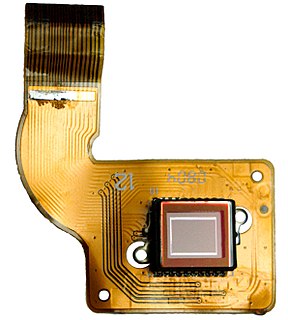
An image sensor or imager is a sensor that detects and conveys information used to make an image. It does so by converting the variable attenuation of light waves into signals, small bursts of current that convey the information. The waves can be light or other electromagnetic radiation. Image sensors are used in electronic imaging devices of both analog and digital types, which include digital cameras, camera modules, medical imaging equipment, night vision equipment such as thermal imaging devices, radar, sonar, and others. As technology changes, digital imaging tends to replace analog imaging.

An active-pixel sensor (APS) is an image sensor where each picture element ("pixel") has a photodetector and an active amplifier. There are many types of integrated circuit active pixel sensors including the complementary metal–oxide–semiconductor (CMOS) APS used most commonly in cell phone cameras, web cameras, most digital pocket cameras since 2010, in most digital single-lens reflex cameras (DSLRs) and Mirrorless interchangeable-lens cameras (MILCs). Such an image sensor is produced using CMOS technology, and has emerged as an alternative to charge-coupled device (CCD) image sensors.

Note: If you came here to get a quick understanding of numbers like 1/2.3, skip ahead to table of sensor formats and sizes. For a simplified discussion of image sensors see image sensor.

The Nikon D3 is a 12.0-megapixel professional-grade full frame (35 mm) digital single lens reflex camera (DSLR) announced by the Nikon Corporation on 23 August 2007 along with the Nikon D300 DX format camera. It was Nikon's first full-frame DSLR. The D3, along with the Nikon D3X, was a flagship model in Nikon's line of DSLRs, superseding the D2Hs and D2Xs. It was replaced by the D3S as Nikon's flagship DSLR. The D3, D3X, D3S, D4, D700, D800 and D800Е are the only Nikon DSLRs manufactured in Japan. The D3S was replaced by the D4 in 2012.

MESA Imaging is a time-of-flight camera company. As privately financed organization, MESA was founded in July 2006 as a spin out from the Swiss Center for Electronics and Microtechnology (CSEM) to commercialize its time-of-flight camera technologies. As of 2009, its primary product line, the SwissRanger, is in its fourth generation with the SwissRanger SR4000. In 2014 MESA was bought by Heptagon

A back-illuminated sensor, also known as backside illumination sensor, is a type of digital image sensor that uses a novel arrangement of the imaging elements to increase the amount of light captured and thereby improve low-light performance.
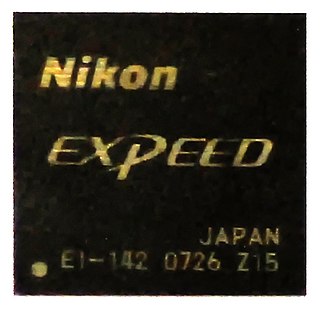
The Nikon Expeed image/video processors are media processors for Nikon's digital cameras. They perform a large number of tasks: Bayer filtering, demosaicing, image sensor corrections/dark-frame subtraction, image noise reduction, image sharpening, image scaling, gamma correction, image enhancement/Active D-Lighting, colorspace conversion, chroma subsampling, framerate conversion, lens distortion/chromatic aberration correction, image compression/JPEG encoding, video compression, display/video interface driving, digital image editing, face detection, audio processing/compression/encoding and computer data storage/data transmission.

The EOS-1Ds is a series of full-frame digital SLR camera bodies made by Canon, first released on 24 September 2002. The series was replaced in March 2012 with the 1D X.

The Fujifilm X-Trans is a CMOS sensor developed by Fujifilm and used in its Fujifilm X-series cameras. Unlike most CMOS sensors featuring a conventional Bayer filter array, X-Trans sensors have a unique 6 by 6 pattern of photosites. Fujifilm claims that this layout can minimise moiré effects, and increase resolution by eliminating the need for a low-pass filter.
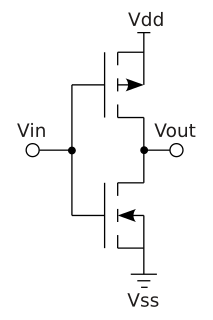
sCMOS is a technology based on next-generation CMOS Image Sensor (CIS) design and fabrication techniques. sCMOS image sensors offer extremely low noise, rapid frame rates, wide dynamic range, high quantum efficiency, high resolution, and a large field of view simultaneously in one image.

